Creating a Cozy One-Bedroom from Your Studio Apartment

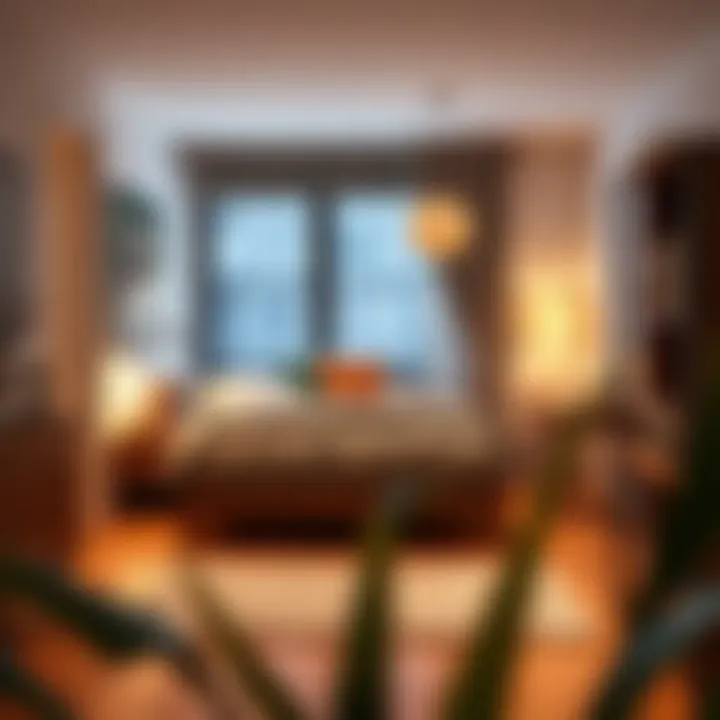
Intro
Creating a one-bedroom sanctuary from a studio apartment is like taking a blank canvas and painting a masterpiece. It’s about imagination and practical application. Many dwellers encounter challenges in making the most of limited square footage. But with some smart strategies and a bit of elbow grease, turning that compact living space into a functional and stylish one-bedroom can transform not only the aesthetics, but also the livability of the environment.
Many people think that a studio, with its all-in-one approach, lacks personality. However, it can be the very spot to showcase creativity and design flair. Think of it as creating distinct zones within that singular space. The end goal? A cozy retreat that feels spacious and welcoming rather than cramped and chaotic.
In this guide, we will explore this transformation journey by focusing on home features that make a difference, followed by interior design inspirations that breathe life into your vision.
Home Features
Architectural Marvels
A studio apartment usually features an open floor plan. This can work to your advantage if you know how to frame different areas correctly. Look for architectural elements that can define spaces subtly. For instance, a half-wall or an open shelf can serve as an effective visual barrier. They split the sleeping area from the living and dining space while maintaining that airy ambiance.
Consider installing some lightweight sliding doors or curtains that you can draw when you need privacy. This not only serves a functional purpose but can also add a layer of sophistication to your design. In some layouts, large windows or a balcony can be appealing as these bring natural light and a sense of openness.
Unique Design Elements
To elevate the charm of your new one-bedroom, play with unique design elements. How about a focal point for the room, such as a piece of artwork or a striking piece of furniture? For example, a bold-colored sofa could anchor your living area while creating a lively contrast against muted walls.
Mirrors can also work wonders in a small space. They reflect light, making areas feel larger than they are. Position a big mirror opposite a window to visually expand your room further.
Along with aesthetics, function is key. Look for multi-functional furniture that cleverly hides away clutter. A sofa bed is the perfect example. It cushions your seating during the day and transforms into a cozy bed at night without consuming extra room.
"Redefining your space doesn't mean compromising on style or comfort, it means maximizing your potential in every square inch."
Understanding these home features can set the foundation for your one-bedroom sanctuary, helping you carve out distinctive areas while infusing style throughout.
Interior Design Inspirations
Color Palettes and Themes
The choice of color plays a vital role in creating the right atmosphere. Light colors can naturally enhance a sense of space, so think soft whites, pastel blues, or neutral grays. Coupled with colorful accents—like throw pillows or artwork—you can add personality without overpowering the room.
In some cases, a dark accent wall can provide depth and dimension. This may break the monotony of lighter tones while offering a cozy vibe. Balance is crucial here; solely relying on dark colors could close off the space.
Furniture Arrangement Tips
Arranging furniture should be strategic. Start by creating a focal point in each area. For the sleeping space, a well-placed bed can define the zone clearly. Position your bed so that it allows easy access while maintaining privacy. Don’t forget, smaller pieces come in handy—like side tables or a nightstand that can also function as a mini desk.
Think about pathways too. Aim for open walkways; the last thing you want is to navigate an obstacle course in your sanctuary. Grouping seating together can also make the space feel more inviting and less isolated.
As you explore these ideas, remember: it’s not just transforming an apartment; it's about creating your personalized haven, tailored to what makes you feel at home.
Understanding the Studio Space
Defining the Characteristics of a Studio
A studio apartment is typically defined by its open-concept layout, combining the living area, kitchen, and sleeping space into a singular area. While this may feel cramped for some, the lack of walls creates a sensation of expansiveness that can be tailored with the right design choices.
Key characteristics include:
- No separate rooms: Everything is interconnected, often leading to flexibility in layout.
- Efficient use of space: Smart design can maximize functionality—what you might lose in distinct areas, you can gain in adaptability.
- Natural light: Studios often feature larger windows, encouraging the use of light to enhance openness and warmth.
"In a small space, every decision matters; choose wisely."
Identifying these qualities not only helps in planning the layout but also assists in envisioning how to cultivate a one-bedroom atmosphere amidst a studio’s inherent charm.
Identifying Limitations and Possibilities
While studios come with their perks, there are limitations that one should be aware of. Recognizing these constraints, however, can pivot the designer's mindset—transforming challenges into opportunities.
Limitations:
- Limited privacy: With an open layout, privacy is often hard to achieve, making it necessary to get creative with zoning techniques.
- Storage issues: Fewer built-in closets mean that maximizing storage is crucial; every nook and cranny must be utilized effectively.
- Decor choices may feel confining: The pressure to choose decor that complements an open space without overwhelming it can be daunting.
Possibilities:
- Personalization: With fewer areas to decorate, you can focus on creating a cohesive personal style that speaks to you.
- Innovative zoning: Using room dividers, furniture placement, or varying colors can help create distinct areas without losing the studio's essence.
- Functional living: Simplifying your living space may lead to a more organized lifestyle and clearer mental space.

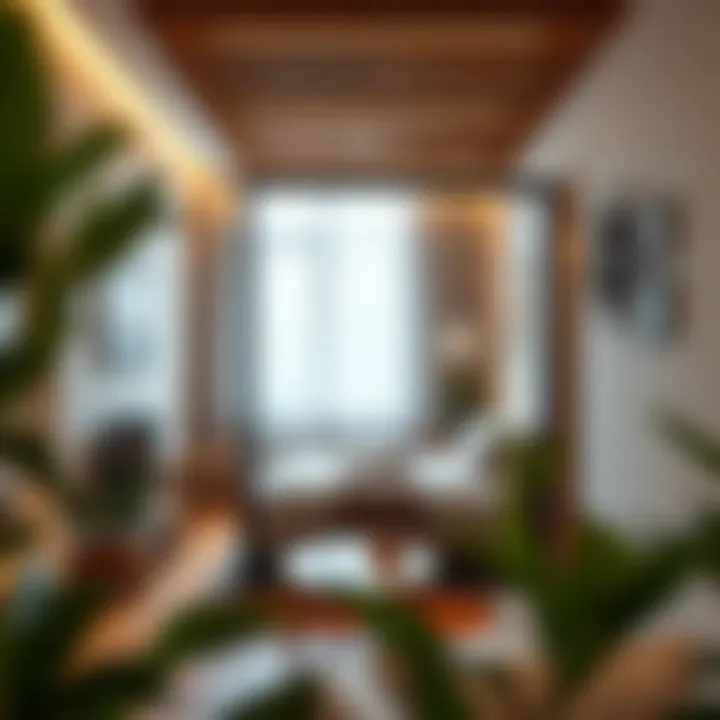
By acknowledging these elements—the positive and the negative—you lay the groundwork for converting a studio apartment into a well-balanced one-bedroom sanctuary, equipped for both style and function.
Conceptualizing the One-Bedroom Layout
When it comes to transitioning from a studio apartment to a one-bedroom layout, one has to embrace the nuances of space management. Just because a studio possesses limited square footage doesn't mean its potential should feel cramped or restrictive. In fact, this is the moment where creativity really comes into play. It’s about smart planning and strategic design to create a sanctuary that feels both functional and welcoming.
Conceptualizing the one-bedroom layout is essential because it allows for a clearer division between living areas and personal space, which is often a significant hurdle in studios.
Space Planning Essentials
Understanding the dynamics of your space is the first step. Start by sketching a rough layout of your studio's current configuration. This initial blueprint will serve as the cornerstone of your redesign. It allows you to visualize where walls may need to go — temporary or otherwise. Consideration needs to be given not only to physical dimensions but also to flow. You want to avoid creating a sense of chaos, which could easily arise from poor placement of furniture or partition walls.
Key elements to keep in mind during this planning phase include:
- Furniture Scale: Just because something looks nice doesn’t mean it fits. Measure your furniture and simulate its size in your drawing. A desktop may look beautiful in a magazine, but introduce it to a small living area, and it can be a recipe for disaster.
- Movement Patterns: Think ahead about how you will move through your space. You must ensure clear pathways to navigate your apartment, giving each area a purpose and dignity.
- Zones: Begin to assign roles to different spaces in your apartment. Is your corner going to serve as a small workstation? Maybe make it cozy with a desk lamp and shelving above it.
Zoning Techniques for Defined Areas
Once you have a blueprint that feels right, the next bit of magic lies in zoning techniques. The goal is to create distinct areas within the apartment that speak to their intended functions, thereby enhancing livability without sacrificing style.
There are various effective methods to reach this objective:
- Furniture Grouping: Use sofas, chairs, or tables to delineate spaces. Placing your sofa to separate the living area from the sleeping quarters is a classic move, but try to mix it up. A clever arrangement of small tables could work just as well.
- Rug Usage: Area rugs can work wonders in visually breaking up your studio. Placing one beneath your dining table will smartly designate eating space.
- Vertical Dividers: Bookshelves or even decorative screens can serve as separators without closing off the space completely. This technique keeps the airy feel of a studio while allowing defined areas.
Shaping your one-bedroom layout isn’t just a practical endeavor; it’s akin to piecing together a personalized puzzle that reflects your lifestyle and personality. It’s about finding the balance between utility and tranquility, and it begins with understanding the space you have at hand.
Furniture Selection and Arrangement
Selecting the right furniture and structuring its arrangement is a pivotal aspect while converting a studio apartment into a functional one-bedroom residence. Unlike larger spaces, studios require deliberate choices that maximize utility without compromising aesthetics. Prioritizing furniture selection hinges on understanding how each piece can serve multiple purposes while still maintaining a cohesive and inviting atmosphere. In this compact living space, one has to think strategically not just in terms of style but the actual functionality that will support day-to-day activities.
A well-thought-out arrangement creates flow, promotes efficiency, and accentuates the illusion of a larger space. It's not merely about placing a sofa here or a table there; it’s about crafting an experience that embodies comfort and organization. The art of arrangement transforms mere furniture into harmonious elements that tell a story of livability.
As the saying goes, "form follows function"—each piece of furniture should not just look good but, more importantly, work well in the context of the larger living space.
Choosing Multifunctional Furniture
When outfitting a studio, opting for multifunctional furniture is akin to striking gold. Imagine a sofa that converts into a bed or an ottoman that opens up to reveal hidden storage. Each piece should pull its weight in terms of utility. This approach not only addresses space limitations but embodies the spirit of modern living.
Here are several examples of multifunctional furniture that can make a significant impact:
- Murphy beds: These beds fold away when not in use, freeing up floor space for other activities.
- Expandable dining tables: Ideal for hosting, these tables can be shrunk down for everyday use and expanded when the occasion calls for it.
- Storage ottomans: Great for seating or as a footrest, they also provide ample space to tuck away items, keeping clutter at bay.
By choosing versatile furniture, one can maximize utility without sacrificing style. It's about thinking creatively and selecting pieces that adapt to the needs of the moment.
Layout Strategies for Efficiency
Layout strategies focus on how furniture is arranged to enhance the functionality of a studio apartment. With limited space, each decision counts.
To create a balanced and efficient layout, consider these strategies:
- Designate Zones: Even within the confines of a studio, you can create distinct areas for sleeping, working, and relaxing. A small bookcase or a small screen can informally separate these zones.
- Create a Focal Point: Whether it’s a beautiful piece of art or a striking piece of furniture, having a focal point can provide a visual anchor that helps organize the space.
- Maintain Clear Walkways: Ensure that there is room to maneuver without obstructions. This enhances the sense of space and keeps the living area functional.
- Avoid Overcrowding: It might be tempting to fill every inch with furniture, but restraint is key. Less is often more in a small space.
"Design is not just what it looks like and feels like. Design is how it works." - Steve Jobs
Efficient layouts ensure that every square inch can be utilized, making the apartment feel more spacious and organized. Prioritizing practicality while being aware of design principles creates an inviting atmosphere where functionality reigns supreme.
In summary, the selection and arrangement of furniture play an instrumental role in not just the visual appeal of a studio-turned-one-bedroom but its very essence of livability. Choosing multifunctional pieces and arranging them effectively goes hand in hand with crafting a space that feels both spacious and personal.
For further insights into smart furniture choices and layout tips, consider visiting resources like Wikipedia or Britannica.
By integrating these thoughtful strategies, one can easily elevate a studio apartment into a true sanctuary.
Creating Privacy and Separation
When it comes to converting a studio into a one-bedroom sanctuary, the distinction of private versus shared space becomes pivotal. In a small living area, privacy may feel like a luxury, but it's essential for maintaining a sense of personal space and comfort. This section explores effective strategies to create both visual and physical separation, enhancing the overall livability of your home.
Using Room Dividers Effectively
Room dividers don't just serve the purpose of separating spaces; they can be a stylish element of decor too. When you think of dividers, the first image might be bulky walls, but that's not the only way. For smaller apartments, lightweight screens can notch a fine balance between function and aesthetics. Consider Japanese shoji screens, or even open shelving units, as they allow light to flow through while creating invisible boundaries.
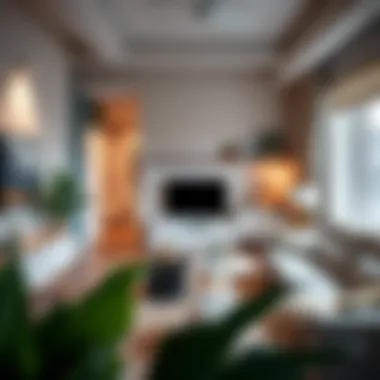
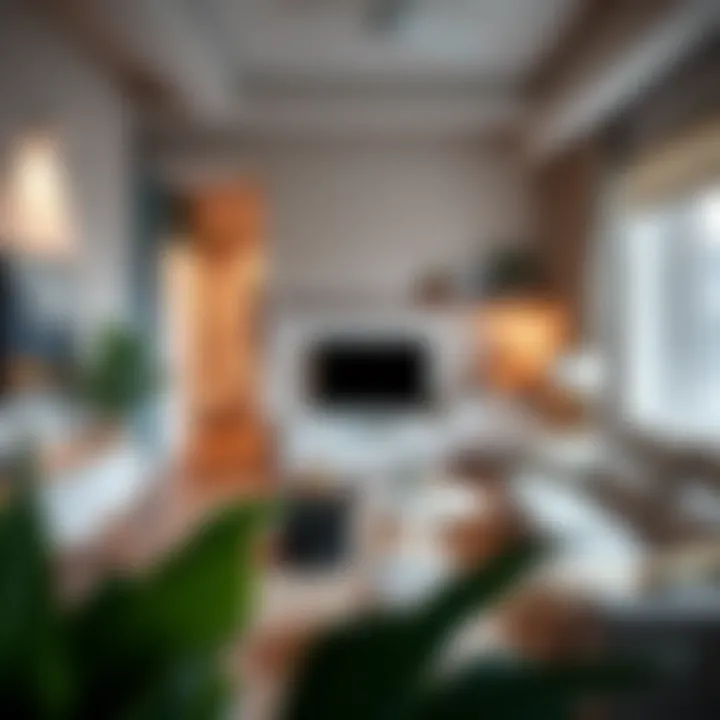
- Decorative Panels: These can blend seamlessly with your decor while offering texture to the room. Choose a design that fits the overall theme of your space.
- Furniture as Dividers: A long bookshelf can separate the sleeping area from the living room, offering both storage and privacy without sacrificing precious square footage.
"In smaller spaces, it’s often better to think vertically to maximize room and depth." This quote underscores the necessity of utilizing every inch of your environment creatively.
Structure is key. Ensure that whatever divider you use doesn’t feel like an afterthought. Select pieces that feel naturally integrated into the space and serve multiple functions if possible.
Incorporating Curtains and Screens
Curtains and screens can provide a different layer of intimacy compared to room dividers. Not only do they offer the ability to quickly adjust your level of privacy, but when drawn, they can transform your space’s atmosphere entirely. Heavy drapes can provide sound insulation, while sheer fabrics can allow plentiful daylight to seep in when you want openness.
- Cohesive Fabric Selection: Choose fabrics that complement your overall color scheme. This cohesive look will tie areas together, rather than creating a jarring visual interruption.
- Smart Use of Rings and Hooks: Hanging curtains with rings or hooks can provide more flexibility in how you choose to open and close them, allowing you to customize the level of openness instantly.
An additional consideration is the height of the curtain rod. Mounting it closer to the ceiling can add the illusion of taller ceilings, expanding your space visually.
Design Aesthetics and Themes
Design aesthetics and themes play a pivotal role in transforming a studio apartment into a haven of comfort and style. The spaces we inhabit communicate a lot about our personalities and preferences, making it crucial to create an environment that resonates with who we are. A well-thought-out aesthetic can also enhance the visual appeal of small spaces, making them feel larger and more open, crucial for a one-bedroom sanctuary.
When one embarks on this journey of transformation, understanding the impact of design aesthetics becomes essential. Color schemes, texture choices, and overall themes can dictate the mood of a room. For instance, soft, cool colors may evoke a sense of tranquility, while warm hues can bring a cozy vibe. Each element contributes significantly to not just visuals but also the overall comfort of the space.
Selecting a Cohesive Color Palette
When picking a color palette, cohesion is the name of the game. A harmonious scheme can visually link different areas of your studio, creating an impression of continuity. Think about how colors influence perception and even emotions. For a space that feels cohesive and inviting, opt for colors that complement each other without overwhelming the eye.
Consider the following tips for selecting your palette:
- Choose a Base Color: Start with a neutral base that can serve as a canvas for the rest of your decor. Shades like whites, grays, or beiges can create a versatile backdrop.
- Add Accent Colors: Introduce one or two accent colors to add warmth or vibrancy. These can be implemented through throw pillows, art pieces, or decorative plants.
- Play with Textures: Different textures can enhance the color palette. A smooth leather sofa paired with plush knit throws can add depth and richness to the overall look.
Keep in mind that lighting affects how colors appear. A shade that looks radiant in natural daylight can seem muted under artificial light, so always test colors before committing.
Incorporating Personal Style
Personal style is what will really make your one-bedroom sanctuary shine. It’s your space after all, so don’t shy away from expressing yourself! Incorporating personal touches can transform a generic studio into a unique sanctuary that tells your story.
Start by reflecting on your interests. Are you an art lover? Hang up pieces that speak to you. Perhaps bold, contemporary-art prints grab your attention; or maybe vintage pieces intrigue you. Mixing different styles can create intrigue but exercise caution to avoid clashing aesthetics.
- Collectibles and Travel Mementos: Drape your walls with photographs or artifacts from your travels. These items allow for personal history to unfold within your living space.
- DIY Projects: If you're crafty, consider a DIY project to create custom furniture or decor items that suit your needs and preferences. Building your own nightstand or creating wall art can be rewarding.
- Add Meaningful Elements: Bring in elements that resonate with personal values or goals, like a vision board or a motivational phrase that you see every day.
Each of these touches not only sets the tone but also creates a conversation starter, making your studio both a personal retreat and a gathering space.
Optimizing Storage Solutions
In the realm of studio apartments, where square footage tends to be as elusive as a needle in a haystack, mastering the art of storage is paramount. Transitioning a cozy studio into a one-bedroom sanctuary requires not just savvy design choices but a keen eye for maximizing every available inch. Storage solutions are not merely functional; they can significantly enhance the aesthetics and livability of your space. By focusing on effective storage, you create an environment that's not just clutter-free, but also enriching to your daily life.
Innovative Storage Ideas
When it comes to innovative storage, thinking outside the box is crucial. Here are some actionable ideas that can transform how you utilize space:
- Furniture with Hidden Storage: Consider investing in bed frames with drawers or ottomans that open up. These can serve dual purposes, providing a comfortable place to sit or rest, while hiding away seasonal wear or extra linens.
- Vertical Space Utilization: Wall-mounted shelves or pegboards can be your best friends. They take advantage of your walls, allowing for creative displays of books, plants, or even artwork while keeping floors clear.
- Modular Units: Choose modular furniture that can be reconfigured as needed. These adaptable choices enable you to change the layout without buying completely new pieces, making them a sustainable option.
- Under-Stair Storage: If your studio has lofted areas, consider building storage into the staircase. This often-overlooked space can become a clever spot to stash shoes or other items without detracting from the overall design.
"A well-designed space is not just visually appealing; it's one that invites ease and efficiency into everyday life."
Built-In Options for Seamless Design
Built-in storage can seamlessly integrate into your studio, providing a clutter-free look. Here are a few ideas:
- Custom Shelving Units: Tailoring shelves to fit the dimensions of your space allows you to optimize every nook and cranny. Whether you extend the shelves up to the ceiling or around a corner, the idea is to maximize vertical height and often unused areas.
- Closet Systems: Installing built-in closets with organization systems can transform a standard closet into a personalized storage haven. Think adjustable shelving, designated shoe compartments, and a place for everything from clothes to accessories.
- Under-Bed Storage Solutions: Raising your bed on a platform? Make use of that space beneath. Drawers or boxes in this area can house less-frequently used items like holiday decor or extra bedding.
- Integrated Desks: A built-in desk can serve as a workspace while providing additional storage options. Design your desk to incorporate shelves above it, allowing for a tidy work area that keeps supplies handy without eating into valuable floor space.
By pinching every ounce of practicality out of your design, not only do you foster organization, but you create a stylish space that reflects who you are. The magic lies in the balance between functionality and aesthetic appeal.
Lighting Considerations
Lighting plays a pivotal role in transforming a studio space into a cozy one-bedroom sanctuary. When you’re working with limited square footage, every detail matters, and lighting choices can make or break the overall atmosphere. The right lighting not only illuminates your area but also enhances your design, dictates mood, and ensures functionality throughout the day and night. Good lighting strategies can help delineate spaces, accentuate decor, and even make your compact living area feel larger and more welcoming.
Layering Light for Functional Spaces
In designing your space, consider the concept of layering light. This involves combining different sources and types of lighting to achieve a well-lit and versatile environment. Imagine your studio divided into areas: a sleeping nook, a small living space, and perhaps a work zone. Each of these areas can benefit from a unique light setup.
- Ambient Lighting: Start with ambient lighting, which provides the general illumination needed for the entire room. Ceiling fixtures or overhead lights serve this purpose well. Opt for soft, warm bulbs to create an inviting feel. If your ceiling is lower, consider flush mount fixtures that don’t intrude into the space visually.
- Task Lighting: Next, integrate task lighting for focused activities. A desk lamp in your workspace is vital; it should provide bright light without being glaring. In the kitchen, under-cabinet lighting can illuminate countertops effectively.
- Accent Lighting: Finally, accent lights can highlight art pieces, plants, or architectural features, adding character to your sanctuary. Think about LED strips or small spotlights that draw the eye to certain elements without overwhelming the space.
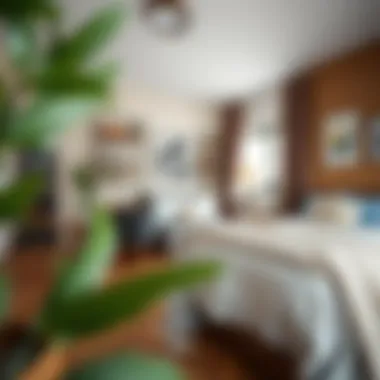
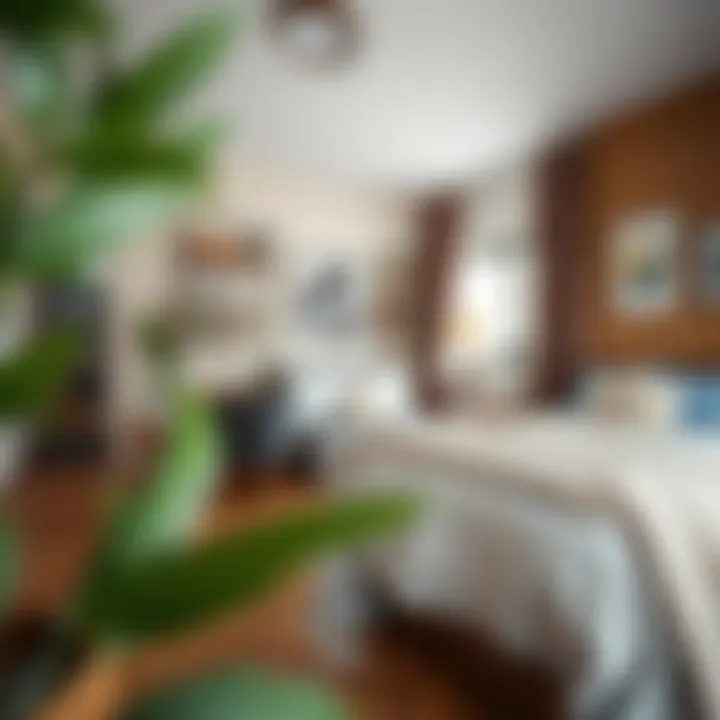
Layering these different styles ensures a functional yet aesthetically pleasing environment, adjusting to your needs as the day transitions into evening.
Maximizing Natural Light
Natural light is a game changer, especially for small apartments. It brings warmth and a sense of openness. Here are a few ways to maximize what you have:
- Use Mirrors: Position mirrors strategically to reflect natural light from windows, amplifying brightness in darker corners. A good trick is placing a large mirror directly across from a window.
- Choose Light Fabrics: For curtains or blinds, opt for light, sheer fabrics that let sunlight spill in while still providing some privacy. Heavy drapes can block valuable light.
- Declutter Window Areas: Avoid keeping large furniture near windows that could hinder the flow of light. A tidy window space can welcome sunlight into your apartment, making it feel larger and airier.
- Paint Colors: Light wall colors can bounce natural light around the room. Soft whites or pastel shades not only brighten up the space but also create an illusion of depth.
In essence, integrating both layered artificial lighting and maximizing natural light creates a dynamic ambiance, enriching the comfort and utility of your new one-bedroom sanctuary.
Integrating Technology
The incorporation of technology into small living spaces cannot be overstated. In a studio apartment, the challenge lies in maximizing both functionality and comfort, and this is where modern tech can play a pivotal role. Smart home solutions help to streamline daily tasks, enhance security, and ultimately create a living space that feels much larger than its physical dimensions. With the rapid advancement in technology, staying updated with what integrates well into compact environments is essential.
Smart Home Solutions for Small Spaces
In recent years, the surge in popularity of smart home devices has brought many new opportunities to optimize studio living. Here are some notable advantages:
- Space-saving Innovations: Many smart devices are designed to be compact. For example, smart speakers like the Amazon Echo Dot or Google Nest Mini take up minimal counter space while offering vast functionality.
- Remote Control and Automation: Utilizing smart systems allows you to control lights, appliances, and even the thermostat from your smartphone or voice-command interfaces. This feature can be a significant boon when juggling daily tasks in a limited space.
- Energy Efficiency: Technological solutions like smart thermostats and LED lighting not only help manage energy consumption but also contribute to lower utility bills. For instance, the Nest Thermostat learns your schedule and adjusts the temperature accordingly, ensuring comfort without wasting energy.
If you're looking to integrate device favorites, try setting up a central hub like Samsung SmartThings, which can unify various smart components into a single platform.
Selecting Appropriate Appliances
In a small apartment, choosing the right appliances can make or break the livability of the space. Here are practical considerations:
- Compact Sizes: Look for appliances that are designed for smaller spaces. Brands like Whirlpool and LG offer compact versions of refrigerators, dishwashers, and washers that still pack powerful performance.
- Energy Ratings: Opting for ENERGY STAR certified appliances benefits both the environment and your wallet. These models consume less energy while providing the same functionality as standard options.
- Multi-functionality: Focus on appliances that can serve multiple purposes. A microwave that also functions as a convection oven or a washer-dryer combo can save valuable square footage.
"Choosing the right technology is not just about what works best; it’s about what fits seamlessly into your life and space."
Investing in technology tailored to small living can transform a studio into a haven of modern convenience. Understanding these smart solutions provides a powerful framework to maximize both space and lifestyle.
Prioritizing Functionality
To prioritize functionality, consider the following key aspects:
- Space Utilization: Every square foot counts in a studio, so taking advantage of vertical space with shelves or overhead storage can streamline the environment.
- Furniture Design: Selecting pieces that serve multiple functions—like a sofa bed or a coffee table with storage—can maximize use without sacrificing aesthetics.
- Traffic Flow: Ensuring that pathways between key areas remain clear supports easier movement throughout the apartment.
The benefits of a functional design extend beyond mere aesthetics; they enhance your quality of life. When a space is intuitively organized, you find it easier to relax and enjoy your home. That’s where creativity shines. For instance, integrating a pull-out desk into an entertainment unit can offer a workspace when needed without permanently dedicating space.
"Functionality isn't just about practicality; it's about creating a comfortable, efficient living experience."
Daily Life Considerations in Design
When it comes to designing for daily life in a studio apartment, several factors come into play. A well-executed layout considers the routine activities of its occupants as well as the flow of daily life. From morning coffee rituals to evening unwinding with a favorite book, paying attention to how spaces serve each aspect of life is paramount.
- Customized Solutions: Assess your daily activities and customize your spaces accordingly. For instance, if cooking is a cherished hobby, investing in an efficient kitchen setup with easy access to tools and ingredients makes life easier.
- Comfort Zones: Creating small, functional areas that cater to specific needs—or even moods—can enhance how the apartment feels. A nook for reading, designed with comfortable seating, encourages flow and harmony in daily tasks.
The aim is to cater to lifestyle demands without overwhelming the space. This nuanced understanding lays the groundwork for a truly livable one-bedroom environment.
Balancing Comfort and Utility
Finding the sweet spot between comfort and utility is an art in itself. In a studio-turned-one-bedroom, you want to create a cozy atmosphere that still feels practical. Here are some effective strategies:
- Layering Textures: Incorporate different textures—like soft rugs, cushions, and warm throws—to add comfort while maintaining practicality.
- Functional Decor: Choose decor items that serve a purpose. For example, decorative baskets can hold blankets or magazines while adding an element of style to the room.
- Flexible Arrangements: Use furniture that can be easily moved or reconfigured to suit different occasions, from a quiet evening at home to hosting a get-together with friends.
Ultimately, the goal is to wrap your daily routine in comfort without losing sight of the everyday utility that your small space demands. Overlapping these two elements leads to a harmonious living space where you feel at home no matter the time of day.
Final Touches and Personalization
Art and Decor for Impact
Art and decor play a significant role in any living space, and in a converted studio, they can be particularly impactful. They serve not just as visual enhancements but as powerful statements that reflect your personality and values.
- Choosing Artwork: Select pieces that resonate with you. This could be a large canvas or a set of smaller prints. An oversized painting can act as a focal point, drawing the eye and breaking up the uniformity of walls.
- Decor Styles: Think about how different styles—the eclectic mix of bohemian with modern minimalism, for instance—can tell your story. Wall hangings, sculptures, or even DIY projects can introduce flair without crowding a small area.
- Express Yourself: Incorporate decor that tells a story. Travel souvenirs, local artisan crafts, or family heirlooms make a space feel lived-in and relatable. Each piece offers an opportunity to reminisce or spark conversation.
In a compact studio, you can hang art strategically to maximize space. Consider using floating shelves or even going vertical with larger pieces that stretch up to the ceiling. This draws the eye upward, giving a sense of spaciousness.
"Art is not what you see, but what you make others see." – Edgar Degas
Creating a Welcome Atmosphere
The ambiance of a space directly influences one's mood and well-being. In the context of a studio apartment, creating a welcome atmosphere means harmonizing comfort with functionality. It’s about setting the stage for relaxation after a long day or a warm welcome for guests.
- Embrace Warm Lighting: Utilizing soft, ambient lighting can make all the difference. Try using string lights or small lamps instead of harsh overhead lighting. Dimmers can also offer you flexibility, transforming a room from bright and lively to soft and cozy with a flick of the switch.
- Textiles Matter: Integrate different textures through cushions, throws, and rugs. They add depth and warmth. A plush, throw blanket draped over a sofa invites you to snuggle up, while a slice of woven wall hanging introduces a tactile element.
- Scent and Sound: Aromatic candles or essential oil diffusers can create a pleasant olfactory experience, setting a soothing atmosphere. Music plays a role too; consider Bluetooth speakers to offer background tunes that enhance the mood during dinner parties or cozy nights in.
Combining these touches ensures that your studio is not just a place to sleep but a refuge that nurtures your spirit and expresses who you are. The personalization you pour into these finishing details transforms your space into a truly one-bedroom sanctuary.



